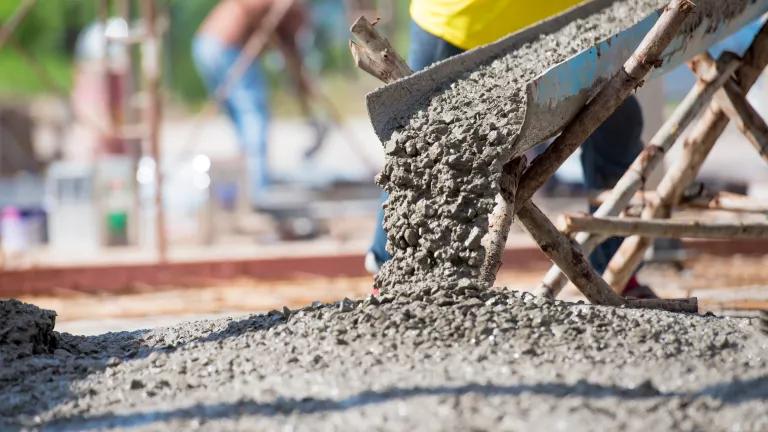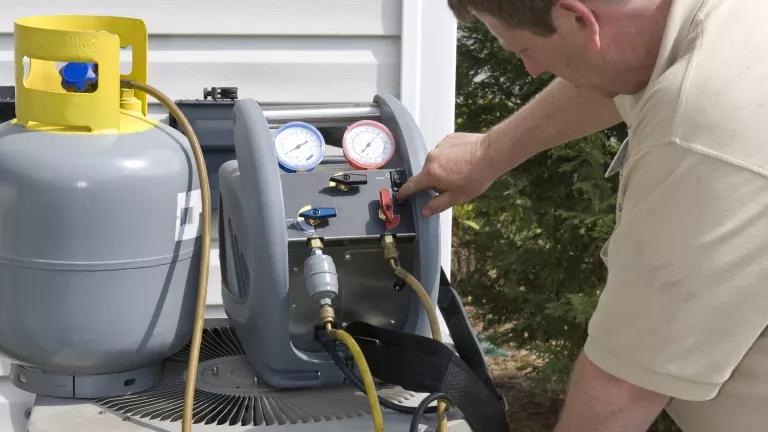With Carbon Capture, Concrete Could One Day Be a Carbon Sink
Concrete’s long-term climate relevance is not limited to emissions reduction: this ubiquitous material could one day serve as a global carbon sink. New and emerging technologies that can capture, utilize and store CO2 across multiple manufacturing phases and components of cement and concrete can permanently lock away heat-trapping emissions in the future.

Concrete is the most widely consumed manmade material on Earth, used across our built environment in buildings, roads, bridges and more. Portland cement, concrete's common binding agent, makes up just 10-15% of the material's mass but accounts for 80-90% of its emissions. Together, the scale at which it is used in the modern world and how emissions intensive it is to produce make cement a top source of climate pollution, responsible for about one-quarter of all industrial emissions of carbon dioxide (CO2) and roughly 7-8% of global CO2 emissions.
Like power and transportation, decarbonizing the cement industry, alongside other industrial sub-sectors like steel, is critical to achieving a net-zero emissions economy. But unlike the internal combustion engine, materials like cement and steel have no readily available replacement and will continue to form the basis of our towns and cities for the next decades—the timeframe most critical to climate action. These industries are also important employers in the United States and a strategically vital part of the American manufacturing base. Taken together, this makes it imperative that we support innovation that allows them to adapt to a carbon free future.
Most emissions from traditional cement production result from chemical reactions in the manufacturing process, not fuel combustion. As a result, full decarbonization of cement will require deploying advanced technologies, such as carbon capture utilization and storage (CCUS), alongside other near-term solutions like improving plant efficiency, fuel switching, and substituting low-carbon alternatives for traditional cement in ready mix concrete. Importantly, carbon capture in cement is not a way to prolong dirty fossil fuels that can be replaced. Instead, it's a way of addressing the largest share of emissions that cannot otherwise be abated for a material we rely on.
However, as detailed in a recent report by Carbon 180, concrete’s long-term climate relevance is not limited to emissions reduction: this ubiquitous material could one day serve as a global carbon sink. New and emerging technologies that can capture, utilize and store CO2 across multiple manufacturing phases and components of cement and concrete can permanently lock away heat-trapping emissions in the future. As summarized by Carbon 180 [bolded emphasis mine],
“At scale, these solutions can one day lead to carbon negative concrete, the point at which more emissions are captured and stored in the material than are generated in its production and use.”
Developing and deploying these technologies for the cement and concrete sectors thus offers the prospect of commercializing a game-changing climate solution, akin to the innovation breakthrough represented by electric vehicles in the transportation sector or heat pumps in home heating.
While CCUS is the commonly used catch-all term, it represents a diverse set of technologies and uses and its application in the cement and concrete sectors can take several unique forms. This includes, but is not limited to, technologies that enable capture and utilization of CO2 directly at cement manufacturing facilities; carbon mineralization methods in which CO2 is captured and injected into fresh concrete where it becomes permanently embedded and actually helps improve its strength; and carbon storage in which CO2 is captured and stored securely in long-term geologic reservoirs (and not used for enhanced oil recovery). Importantly, the pretreatment required to separate CO2 from the flue gas of cement plants also reduces harmful local air pollutants like particulate matter and sulfur dioxide.
Pioneering companies are already showing these new practices work at commercial scale.
One example of carbon utilization is the technology currently being pioneered by Fortera at a cement plant in Redding, California. Fortera will capture CO2 normally emitted as exhaust from cement manufacturing at the plant and feed it back into the kiln, reducing CO2 loss and thus significantly improving the efficiency with which raw limestone is turned into cement. The result, according to the company, is a product that’s 60% less emissions intensive and can be blended with ordinary Portland cement as a supplementary cementitious material at a ratio of roughly 20%.
Solidia, a cement manufacturer based in New Jersey, is putting CO2 from post-industrial sources to use to cut the ratio of limestone in its cement, substantially reducing process and energy emissions at its kilns.
And Halifax-based CarbonCure has pioneered a carbon mineralization method for both ready mix and precast concrete. A Carbon XPrize winner, the company’s technology is now deployed in nearly 400 concrete plants in North America and globally.
And this is just a sample of early leaders in this fast-evolving sector.
Supporting these and other advanced technological solutions, as well as carbon capture and storage projects at industrial facilities, which don’t yet exist at commercial scale, will require an innovation agenda backed by a package of industrial decarbonization policies. This should include major investments in RD&D in labs, enhanced tax incentives for first-of-a-kind demonstration projects, and green procurement initiatives that leverage the purchasing power of the government to build early markets for low-carbon industrial products like concrete, ultimately paving the way for market-wide standards.
As my colleagues and I discussed here, President Biden’s ambitious American Jobs Plan charts this course.
For years, U.S. climate policies have prioritized decarbonizing other sectors of the economy, such as power and transportation. In comparison, relatively few policies have focused on decarbonizing heavy industry. We need to apply America’s unparalleled innovation and ingenuity to reduce pollution and strengthen our industrial and manufacturing sectors, creating more high-quality jobs and making us leaders in low-carbon production.
In a recent interview, Brian Deese, the Biden administration’s Director of the National Economic Council, summed up the opportunity this way:
“On the industry side, both investing in R&D and in the deployment of new technologies that will help US industry lead in creating low-carbon or zero-carbon industrial applications to the future, whether that’s low carbon materials, steel, cement, or in zero-carbon areas like CCS and hydrogen. Those are places where you need public investment to actually help unlock new breakthroughs. And we have a big stake in having that innovation happen in the United States and then having the manufacturing happen co-located with the innovation.”
We can do this while we make better products, like cement that is not just significantly less polluting but that is also a stronger, better product.


